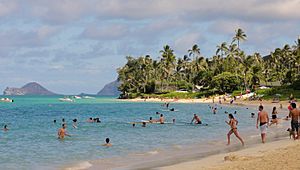Hawaiian Islands facts for kids
|
Native name:
Mokupuni Hawai‘i
|
|
|---|---|
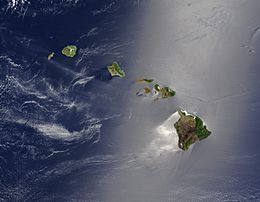
The Windward Islands of Hawaii
|
|
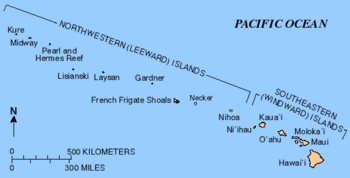 |
|
| Geography | |
| Location | North Pacific Ocean |
| Coordinates | 20°54′00″N 156°36′00″W / 20.90000°N 156.60000°W |
| Total islands | 137 |
| Highest point |
|
| Administration | |
|
United States
|
|
| State | Hawaii |
| Unincorporated territory | Midway Atoll |
| Largest settlement | Honolulu |
The Hawaiian Islands (Hawaiian: Mokupuni Hawai‘i) are an archipelago of eight major volcanic islands, several atolls, and numerous smaller islets in the North Pacific Ocean, extending some 1,500 miles (2,400 kilometers) from the island of Hawaiʻi in the south to northernmost Kure Atoll. Formerly called the Sandwich Islands by Europeans (not by Kānaka Maoli, the people native to the islands), the present name for the archipelago is derived from the name of its largest island, Hawaiʻi.
The archipelago sits on the Pacific Plate. The islands are exposed peaks of a great undersea mountain range known as the Hawaiian–Emperor seamount chain, formed by volcanic activity over a hotspot in the Earth's mantle. The islands are about 1,860 miles (3,000 km) from the nearest continent and are part of the Polynesia subregion of Oceania.
The U.S. state of Hawaii occupies the archipelago almost in its entirety (including the mostly uninhabited Northwestern Hawaiian Islands), with the sole exception of Midway Atoll (a United States Minor Outlying Island). Hawaii is the only U.S. state that is situated entirely on an archipelago, and the only state not geographically connected with North America. The Northwestern islands (sometimes called the Leeward Islands) and surrounding seas are protected as a National Monument and World Heritage Site.
Contents
Islands and reefs
The date of the first settlements of the Hawaiian Islands is a topic of continuing debate. Archaeological evidence seems to indicate a settlement as early as 124 AD.
Captain James Cook, RN, visited the islands on January 18, 1778, and named them the "Sandwich Islands" in honor of The 4th Earl of Sandwich, who as the First Lord of the Admiralty was one of his sponsors. This name was in use until the 1840s, when the local name "Hawaii" gradually began to take precedence.
The Hawaiian Islands have a total land area of 6,423.4 square miles (16,636.5 km2). Except for Midway, which is an unincorporated territory of the United States, these islands and islets are administered as Hawaii—the 50th state of the United States.
Major islands
| Island | Nickname | Area | Population (as of 2010) |
Density | Highest point | Elevation | Age (Ma) | Location |
|---|---|---|---|---|---|---|---|---|
| Hawaiʻi | The Big Island | 4,028.0 sq mi (10,432.5 km2) | 185,079 | 45.948/sq mi (17.741/km2) | Mauna Kea | 13,796 ft (4,205 m) | 0.4 | 19°34′N 155°30′W / 19.567°N 155.500°W |
| Maui | The Valley Isle | 727.2 sq mi (1,883.4 km2) | 144,444 | 198.630/sq mi (76.691/km2) | Haleakalā | 10,023 ft (3,055 m) | 1.3–0.8 | 20°48′N 156°20′W / 20.800°N 156.333°W |
| Oʻahu | The Gathering Place | 596.7 sq mi (1,545.4 km2) | 953,207 | 1,597.46/sq mi (616.78/km2) | Mount Kaʻala | 4,003 ft (1,220 m) | 3.7–2.6 | 21°28′N 157°59′W / 21.467°N 157.983°W |
| Kauaʻi | The Garden Isle | 552.3 sq mi (1,430.5 km2) | 66,921 | 121.168/sq mi (46.783/km2) | Kawaikini | 5,243 ft (1,598 m) | 5.1 | 22°05′N 159°30′W / 22.083°N 159.500°W |
| Molokaʻi | The Friendly Isle | 260.0 sq mi (673.4 km2) | 7,345 | 28.250/sq mi (10.907/km2) | Kamakou | 4,961 ft (1,512 m) | 1.9–1.8 | 21°08′N 157°02′W / 21.133°N 157.033°W |
| Lānaʻi | The Pineapple Isle | 140.5 sq mi (363.9 km2) | 3,135 | 22.313/sq mi (8.615/km2) | Lānaʻihale | 3,366 ft (1,026 m) | 1.3 | 20°50′N 156°56′W / 20.833°N 156.933°W |
| Niʻihau | The Forbidden Isle | 69.5 sq mi (180.0 km2) | 170 | 2.45/sq mi (0.95/km2) | Mount Pānīʻau | 1,250 ft (381 m) | 4.9 | 21°54′N 160°10′W / 21.900°N 160.167°W |
| Kahoʻolawe | The Target Isle | 44.6 sq mi (115.5 km2) | 0 | 0 | Puʻu Moaulanui | 1,483 ft (452 m) | 1.0 | 20°33′N 156°36′W / 20.550°N 156.600°W |
The eight major islands of Hawaii (Windward Islands) are listed above. All except Kaho'olawe are inhabited.
Minor islands, islets
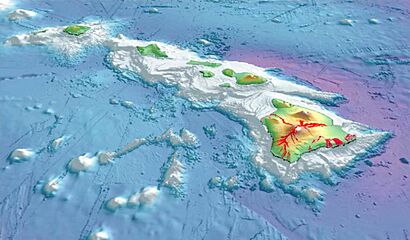

The state of Hawaii counts 137 "islands" in the Hawaiian chain. This number includes all minor islands (small islands), islets (even smaller islands) offshore of the major islands (listed above), and individual islets in each atoll. These are just a few:
- Kaʻula
- Kāohikaipu
- Lehua
- Mānana
- Mōkōlea Rock
- [[Mokoliʻi]]
- Moku Manu
- Mokuauia
- Moku o Loʻe
- Moku Ola
- Mokuʻumeʻume
- Molokini
- Nā Mokulua
Partial islands, atolls, reefs

Partial islands, atolls, reefs—those west of Niʻihau are uninhabited except Midway Atoll—form the Northwestern Hawaiian Islands (Leeward Islands):
- Nihoa (Mokumana)
- Necker (Mokumanamana)
- French Frigate Shoals (Kānemilohaʻi)
- Gardner Pinnacles (Pūhāhonu)
- Maro Reef (Nalukākala)
- Laysan (Kauō)
- Lisianski Island (Papaʻāpoho)
- Pearl and Hermes Atoll (Holoikauaua)
- Midway Atoll (Pihemanu)
- Kure Atoll (Mokupāpapa)
Geology
This chain of islands, or archipelago, developed as the Pacific Plate slowly moved northwestward over a hotspot in the Earth's mantle at a rate of approximately 32 miles (51 km) per million years. Thus, the southeast island is volcanically active, whereas the islands on the northwest end of the archipelago are older and typically smaller, due to longer exposure to erosion. The age of the archipelago has been estimated using potassium-argon dating methods. From this study and others, it is estimated that the northwesternmost island, Kure Atoll, is the oldest at approximately 28 million years (Ma); while the southeasternmost island, Hawaiʻi, is approximately 0.4 Ma (400,000 years). The only active volcanism in the last 200 years has been on the southeastern island, Hawaiʻi, and on the submerged but growing volcano to the extreme southeast, Kamaʻehuakanaloa (formerly Loʻihi). The Hawaiian Volcano Observatory of the USGS documents recent volcanic activity and provides images and interpretations of the volcanism. Kīlauea had been erupting nearly continuously since 1983 when it stopped August 2018.
Almost all of the magma of the hotspot has the composition of basalt, and so the Hawaiian volcanoes are composed almost entirely of this igneous rock. There is very little coarser-grained gabbro and diabase. Nephelinite is exposed on the islands but is extremely rare. The majority of eruptions in Hawaiʻi are Hawaiian-type eruptions because basaltic magma is relatively fluid compared with magmas typically involved in more explosive eruptions, such as the andesitic magmas that produce some of the spectacular and dangerous eruptions around the margins of the Pacific basin.
Hawaiʻi island (the Big Island) is the biggest and youngest island in the chain, built from five volcanoes. Mauna Loa, taking up over half of the Big Island, is the largest shield volcano on the Earth. The measurement from sea level to summit is more than 2.5 miles (4 km), from sea level to sea floor about 3.1 miles (5 km).
Earthquakes
The Hawaiian Islands have many earthquakes, generally triggered by and related to volcanic activity. Seismic activity, as a result, is currently highest in the southern part of the chain. Both historical and modern earthquake databases have correlated higher magnitude earthquakes with flanks of active volcanoes, such as Mauna Loa and Kilauea. The combination of erosional forces, which cause slumping and landslides, with the pressure exerted by rising magma put a great amount of stress on the volcanic flanks. The stress is released when the slope fails, or slips, causing an earthquake. This type of seismicity is unique because the forces driving the system are not always consistent over time, since rates of volcanic activity fluctuate. Seismic hazard near active, seaward volcanic flanks is high, partially because of the especially unpredictable nature of the forces that trigger earthquakes, and partially because these events occur at relatively shallow depths. Flank earthquakes typically occur at depths ranging from 5 to 20 km, increasing the hazard to local infrastructure and communities. Earthquakes and landslides on the island chain have also been known to cause tsunamis.
Most of the early earthquake monitoring took place in Hilo, by missionaries Titus Coan and Sarah J. Lyman and her family. Between 1833 and 1896, approximately 4 or 5 earthquakes were reported per year. Today, earthquakes are monitored by the Hawaiian Volcano Observatory run by the USGS.
Hawaii accounted for 7.3% of the United States' reported earthquakes with a magnitude 3.5 or greater from 1974 to 2003, with a total 1533 earthquakes. Hawaii ranked as the state with the third most earthquakes over this time period, after Alaska and California.
On October 15, 2006, there was an earthquake with a magnitude of 6.7 off the northwest coast of the island of Hawaii, near the Kona area. The initial earthquake was followed approximately five minutes later by a magnitude 5.7 aftershock. Minor to moderate damage was reported on most of the Big Island. Several major roadways became impassable from rock slides, and effects were felt as far away as Honolulu, Oahu, nearly 150 miles (240 km) from the epicenter. Power outages lasted for several hours to days. Several water mains ruptured. No deaths or life-threatening injuries were reported.
On May 4, 2018, there was a 6.9 earthquake in the zone of volcanic activity from Kīlauea.
Earthquakes are monitored by the Hawaiian Volcano Observatory run by the USGS.
Tsunamis
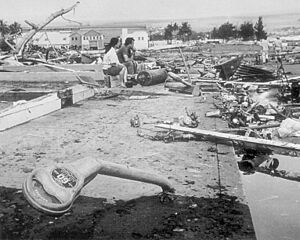
The Hawaiian Islands are subject to tsunamis, great waves that strike the shore. Tsunamis are most often caused by earthquakes somewhere in the Pacific. The waves produced by the earthquakes travel at speeds of 400–500 miles per hour (600–800 km/h) and can affect coastal regions thousands of miles (kilometers) away.
Tsunamis may also originate from the Hawaiian Islands. Explosive volcanic activity can cause tsunamis. The island of Molokaʻi had a catastrophic collapse or debris avalanche over a million years ago; this underwater landslide likely caused tsunamis. The Hilina Slump on the island of Hawaiʻi is another potential place for a large landslide and resulting tsunami.
The city of Hilo on the Big Island has been most affected by tsunamis, where the in-rushing water is accentuated by the shape of Hilo Bay. Coastal cities have tsunami warning sirens.
A tsunami resulting from an earthquake in Chile hit the islands on February 27, 2010. It was relatively minor, but local emergency management officials utilized the latest technology and ordered evacuations in preparation for a possible major event. The Governor declared it a "good drill" for the next major event.
A tsunami resulting from an earthquake in Japan hit the islands on March 11, 2011. It was relatively minor, but local officials ordered evacuations in preparation for a possible major event. The tsunami caused about $30.1 million in damages.
Volcanoes
Only the two Hawaiian islands furthest to the southeast have active volcanoes: Haleakalā on Maui, and Mauna Loa, Mauna Kea, Kilauea, and Hualalai, all on the Big Island. The volcanoes on the remaining islands are extinct as they are no longer over the Hawaii hotspot. The Kamaʻehuakanaloa Seamount is an active submarine volcano that is expected to become the newest Hawaiian island when it rises above the ocean's surface in 10,000–100,000 years. Hazards from these volcanoes include lava flows that can destroy and bury the surrounding surface, volcanic gas emissions, earthquakes and tsunamis listed above, submarine eruptions affecting the ocean, and the possibility of an explosive eruption.
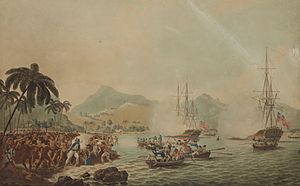
History
There is no definitive date for the Polynesian discovery of Hawaii. However, high-precision radiocarbon dating in Hawaii using chronometric hygiene analysis, and taxonomic identification selection of samples, puts the initial first settlement of the Hawaiian Islands sometime between 1219 and 1266 A.D., originating from earlier settlements first established in the Society Islands around 1025 to 1120 A.D., and in the Marquesas Islands sometime between 1100 and 1200 A.D. no The history of Hawaii describes the era of human settlements in the Hawaiian Islands. The islands were first settled by Polynesians sometime between 124 and 1120 AD. Hawaiian civilization was isolated from the rest of the world for at least 500 years.
An expedition led by British explorer James Cook is usually considered to be the first group of Europeans to arrive in the Hawaiian Islands, which they did in 1778. However, Spanish historians and some other researchers state that the Spanish captain Ruy López de Villalobos was the first European to see the islands in 1542. The Spanish named these islands "Isla de Mesa, de los Monjes y Desgraciada" (1542), being on the route linking the Philippines with Mexico across the Pacific Ocean, between the ports of Acapulco and Manila, which were both part of New Spain. Within five years after Cook's arrival, European military technology helped Kamehameha I, ruler of the island of Hawaii, conquer and unify the islands for the first time, establishing the Kingdom of Hawaii in 1795. The kingdom was prosperous and important for its agriculture and strategic location in the Pacific.
American immigration, led by Protestant missionaries, and Native Hawaiian outmigration, mostly on whaling ships, began almost immediately after Cook's arrival. Americans set up plantations to grow sugar. Their methods of plantation farming required substantial labor. Waves of permanent immigrants came from Japan, China, and the Philippines to work in the fields. The government of Japan organized and gave special protection to its people, who comprised about 25 percent of the Hawaiian population by 1896. The Hawaiian monarchy encouraged this multi-ethnic society, initially establishing a constitutional monarchy in 1840 that promised equal voting rights regardless of race, gender, or wealth.
The population of Native Hawaiians in Hawaii declined from an unknown number prior to 1778 (commonly estimated to be around 300,000), to around 142,000 in the 1820s based on the first census conducted by American missionaries, 82,203 in the 1850 Hawaiian Kingdom census, 40,622 in the last Hawaiian Kingdom census of 1890, 39,504 in the only census by the Republic of Hawaii in 1896, and 37,656 in the first census conducted by the United States in 1900 after the annexation of Hawaii to the United States in 1898. Since Hawaii has joined the United States the Native Hawaiian population in Hawaii has increased with every census to 289,970 in 2010.
Americans within the kingdom government rewrote the constitution, severely curtailing the power of King "David" Kalākaua, and disenfranchising the rights of most Native Hawaiians and Asian citizens to vote, through excessively high property and income requirements. This gave a sizeable advantage to plantation owners. Queen Liliʻuokalani attempted to restore royal powers in 1893 but was placed under house arrest by businessmen with help from the United States military. Against the Queen's wishes, the Republic of Hawaii was formed for a short time. This government agreed on behalf of Hawaii to join the United States in 1898 as the Territory of Hawaii. In 1959, the islands became the state of Hawaii. no
Ecology
The islands are home to a multitude of endemic species. Since human settlement, first by Polynesians, non native trees, plants, and animals were introduced. These included species such as rats and pigs, that have preyed on native birds and invertebrates that initially evolved in the absence of such predators. The growing population of humans, especially through European and American colonisation and development, has also led to deforestation, forest degradation, treeless grasslands, and environmental degradation. As a result, many species which depended on forest habitats and food became extinct—with many current species facing extinction. As humans cleared land for farming with the importation of industrialized farming practices through European and American encroachment, monocultural crop production replaced multi-species systems.
The arrival of the Europeans had a more significant impact, with the promotion of large-scale single-species export agriculture and livestock grazing. This led to increased clearing of forests, and the development of towns, adding many more species to the list of extinct animals of the Hawaiian Islands. As of 2009[update], many of the remaining endemic species are considered endangered.
National Monument
On June 15, 2006, President George W. Bush issued a public proclamation creating Papahānaumokuākea Marine National Monument under the Antiquities Act of 1906. The Monument encompasses the northwestern Hawaiian Islands and surrounding waters, forming the largest marine wildlife reserve in the world. In August 2010, UNESCO's World Heritage Committee added Papahānaumokuākea to its list of World Heritage Sites. On August 26, 2016, President Barack Obama greatly expanded Papahānaumokuākea, quadrupling it from its original size.
Climate
The Hawaiian Islands are tropical but experience many different climates, depending on altitude and surroundings. The islands receive most rainfall from the trade winds on their north and east flanks (the windward side) as a result of orographic precipitation. Coastal areas in general and especially the south and west flanks, or leeward sides, tend to be drier.
In general, the lowlands of Hawaiian Islands receive most of their precipitation during the winter months (October to April). Drier conditions generally prevail from May to September. The tropical storms, and occasional hurricanes, tend to occur from July through November.
During the summer months the average temperature is about 84 °F (29 °C), in the winter months it is approximately 79 °F (26 °C). As the temperature is relatively constant over the year the probability of dangerous thunderstorms is approximately low.
See also
 In Spanish: Archipiélago de Hawái para niños
In Spanish: Archipiélago de Hawái para niños





